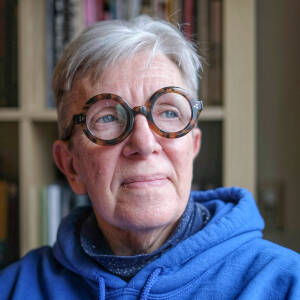Doing the work
I went down to the demonstration at about 7 a.m. and stayed till nearly 9. After I left, the mayor held a special meeting of the city council in a secret room and passed the police contract he wanted, 3 in favor, 1 opposed, 1 abstaining. Soon after that, the protesters entered city hall, the police showed up to push them away, and all hell broke loose. If you can bear the brutality and the screaming, you can see it here. I heard that the beautiful young man in this photo wearing a red hoodie, was thrown down the stairs and beaten with billy clubs. Of reportedly nine who were arrested, three were photographers.
With Sue's help, I crafted the following statement, which I posted on Facebook with 40 portraits of activists:
Love is what motivates me. Anger is not enough. Protest is not enough.
I see that we are all one people, all connected, all breathing together for a brief, vulnerable moment. But some of us are targeted by racism and racist violence supported by racist policing. Some who are not targeted by racism can ignore it, can look the other way. That supports racism. Undoing racism means we need all people to see it clearly, see the injustice and the violence of it, so we can work together to change it. Racism is in the air we breathe, and it poisons us all. How can we cleanse the air? Different strategies are required. I support each person finding a strategy that works for them, so long as it keeps them doing something to un-do racism.
I was born 71 years ago in a North Carolina town divided by railroad tracks. Whites on one side. Blacks on the other. My grandfather worked on the black side, and he took his bastard grandchild, me, with him to work every day till I was five. My grandmother couldn’t take me to her job, and they were poor working people who needed both incomes. I felt I belonged on the black side of town, and my first question was WHY. Why is the town divided? In my teens I fled to Atlanta, where in 1964 I joined the Quakers and took part in lunch counter sit-ins. In my twenties I went to New York, where I worked on the West Side and in Harlem as a counselor for former heroin addicts. I wasn’t strong enough to live in New York so I escaped to New Orleans and worked with community organizers and anti-racism people. My people. In my forties I went to Africa where I taught theatre for social change. I stayed in Africa six years, till I hit my fifties and came back to the mess that was America in the Bush years. Now I am in Portland, and my hair is white and my time is almost up, so I ask WHEN. When will we make a world that is safe for all the children? When will we take the tools of violence out of the hands of those who support white supremacy?
Now I do photography for social justice. My job, as I understand it, is to communicate love so others can see it and join in helping to break down systemic racism. If a photograph can help others to see the beauty I see, and to love that beauty enough to do this work, wonderful. If a demonstration can strengthen the bonds between those who participate in it, and can activate the love in those who are bystanders, wonderful. If a protest brings attention to the issues, wonderful. If a song, a chant, a story, a portrait, a moment of theatre--in the streets or on a stage--can help people to join the shift in consciousness away from white supremacy and toward love and safety for all people, wonderful. It's not about the leaders of the various strategies, whether they agree or not. It's about shifting the whole world out of unconsciousness into a deeply felt understanding that we must abolish racist culture in order to build a safe world for all the children.
I made a few changes when I posted it, but that's basically my manifesto. If you follow my journal, you have heard all this before.
Micah, the young man in the red hoodie, was treated in hospital and is now reportedly home, safe. I am told they don't think he sustained brain injury from the beating with billy clubs. I hope that is true.

Comments New comments are not currently accepted on this journal.